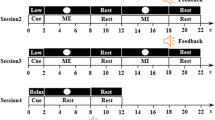Abstract
Bringing a Brain–Computer Interface (BCI) out of the lab one of the main problems has to be solved: to shorten the training time. Finding a solution for this problem, the use of a BCI will be open not only for people who have no choice, e.g., persons in a locked-in state, or suffering from a degenerating nerve disease. By reducing the training time to a minimum, also healthy persons will make use of the system, e.g., for using this kind of control for games. For realizing such a control, the post-movement beta rebound occurring after brisk feet movement was used to set up a classifier. This classifier was then used in a cue-based motor imagery system. After classifier adaptation, a self-paced brain-switch based on brisk foot motor imagery (MI) was evaluated. Four out of six subjects showed that a post-movement beta rebound after feet MI and succeeded with a true positive rate between 69 and 89%, while the positive predictive value was between 75 and 93%.

Similar content being viewed by others
References
Alegre M, Labarga A, Gurtubay IG, Iriarte J, Malanda A, Artieda J (2002) Beta electroencephalograph changes during passive movements: sensory afferences contribute to beta event-related desynchronization in humans. Neurosci Lett 331:29–32
Cassim F, Monaca C, Szurhaj W, Bourriez JL, Defebvre L, Derambure P, Guieu JD (2001) Does post-movement beta synchronization reflect an idling motor cortex? Neuroreport 12:3859–3863
Davison AC (1997) Bootstrap methods and their application. Cambridge University Press, Cambridge
Fatourechi M, Ward RK, Birch GE (2008) A self-paced brain–computer interface system with a low false positive rate. J Neural Eng 5:9–23. doi:10.1088/1741-2560/5/1/002
Leeb R, Settgast V, Fellner DW, Pfurtscheller G (2007) Self-paced exploring of the Austrian National Library through thoughts. Int J Bioelectromagn 9:237–244
Makeig S, Debener S, Onton J, Delorme A (2004) Mining event-related brain dynamics. Trends Cogn Sci 8:204–210
Mason SG, Birch GE (2000) A brain-controlled switch for asynchronous control applications. IEEE Trans Biomed Eng 47:1297–1307
Müller GR, Neuper C, Rupp R, Keinrath C, Gerner HJ, Pfurtscheller G (2003) Event-related beta EEG changes during wrist movements induced by functional electrical stimulation of forearm muscles in man. Neurosci Lett 340:143–147
Müller-Putz GR, Zimmermann D, Graimann B, Nestinger K, Korisek G, Pfurtscheller G (2007) Event-related beta EEG-changes during passive and attempted foot movements in paraplegic patients. Brain Res 1137:84–91. doi:10.1016/j.brainres.2006.12.052
Neuper C, Pfurtscheller G (2001) Evidence for distinct beta resonance frequencies in human EEG related to specific sensorimotor cortical areas. Clin Neurophysiol 112:2084–2097
Pfurtscheller G, Lopes da Silva FH (1999) Event-related EEG/MEG synchronization and desynchronization: basic principles. Clin Neurophysiol 110:1842–1857. doi:10.1016/S1388-2457(99)00141-8)
Pfurtscheller G, Neuper C (1997) Motor imagery activates primary sensorimotor area in humans. Neurosci Lett 239:65–68
Pfurtscheller G, Solis-Escalante T (2009) Could the beta rebound in the EEG be suitable to realize a “brain switch”? Clin Neurophysiol 120:24–29. doi:10.1016/j.clinph.2008.09.027
Pfurtscheller G, Zalaudek K, Neuper C (1998) Event-related beta synchronization after wrist, finger and thumb movement. Electroencephalogr Clin Neurophysiol 9:154–160. doi:10.1016/S0924-980X(97)00070-2
Pfurtscheller G, Guger C, Müller G, Krausz G, Neuper C (2000) Brain oscillations control hand orthosis in a tetraplegic. Neurosci Lett 292:211–214. doi:10.1016/S0304-3940(00)01471-3
Pfurtscheller G, Neuper C, Pichler-Zalaudek K, Edlinger G, da Silva FHL (2000) Do brain oscillations of different frequencies indicate interaction between cortical areas in humans? Neurosci Lett 286:66–68
Pfurtscheller G, Neuper C, Brunner C, da Silva FHL (2005) Beta rebound after different types of motor imagery in man. Neurosci Lett 378:156–159
Salmelin R, Hamalainen M, Kajola M, Hari R (1995) Functional segregation of movement related rhythmic activity in the human brain. NeuroImage 2:237–243. doi:10.1006/nimg.1995.1031
Schnitzler A, Salenius S, Salmelin R, Jousmki V, Hari R (1997) Involvement of primary motor cortex in motor imagery: a neuromagnetic study. NeuroImage 6:201–208
Stanck A, Feige B, Lücking CH, Kristeva-Feige R (2000) Oscillatory cortical activity and movement-related potentials in proximal and distal movements. Clin Neurophysiol 111(4):636–650
Acknowledgments
The authors would like to thank Dr. Clemens Brunner for fruitful discussions. This study was supported by the Lorenz-Boehler Gesellschaft, Allgemeine Unfallversicherungsanstalt (AUVA), Wings for Life—Spinal Cord Research Foundation, EU funded PRESENCCIA (IST-2006-27731).
Author information
Authors and Affiliations
Corresponding author
Rights and permissions
About this article
Cite this article
Müller-Putz, G.R., Kaiser, V., Solis-Escalante, T. et al. Fast set-up asynchronous brain-switch based on detection of foot motor imagery in 1-channel EEG. Med Biol Eng Comput 48, 229–233 (2010). https://doi.org/10.1007/s11517-009-0572-7
Received:
Accepted:
Published:
Issue Date:
DOI: https://doi.org/10.1007/s11517-009-0572-7




